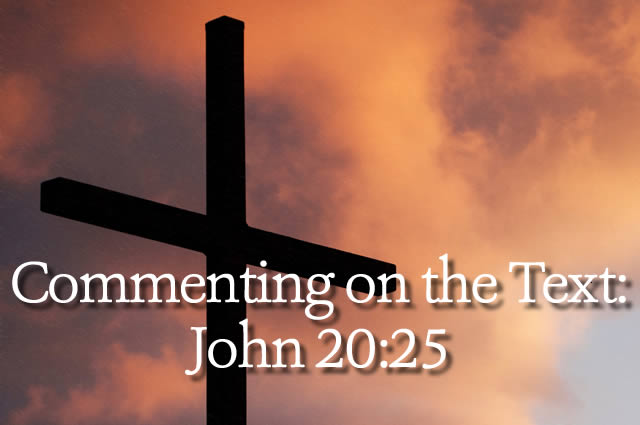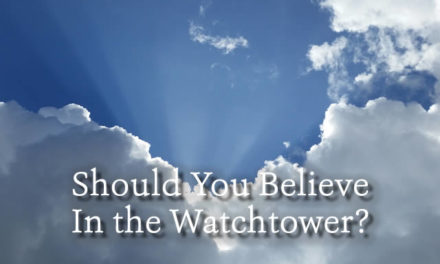June 2002
Consequently the other disciples would say to him: ‘We have seen the Lord!’ But he said to them: ‘Unless I see in his hands the print of the nails and stick my finger into the print of the nails and stick my hand into his side, I will certainly not believe’.
The Watchtower Society teaches that Jesus was impaled on an upright pole with his hands extended directly above his head. The Bible teaches, and Christians believe, that Jesus was crucified on a cross with his arms extended out at about 90 degrees from his body.
They also say that Jesus did not rise bodily from the grave but manifested various bodily forms so as to be seen by His disciples. However, this text refutes both Watchtower positions.
The Jehovah’s Witnesses will say that the cross is of pagan origin. It is associated in their book Reasoning From the Scriptures (pages 90, 91) with various ancient gods such as Bacchus, Tammuz, Bel, and Odin.
By this association the Witnesses will say that true Christians should not display the cross. Nor should they think that Jehovah would permit His Son to be murdered on it. Their logic defies even common sense. It was not a godly group of people who put Jesus on the cross. The utter humiliation of our Savior may have included the satanic inspiration of the method as well as the other humiliating factors such as being numbered with the transgressors, and being put to death outside the city of Jerusalem.
If the Watchtower were correct Jesus would have been nailed to the pole with just one nail through both arms. This is how they depict his death in their published artwork. Their own wording in the New World Translation refutes them. In the text cited above Jesus was pierced with two nails, not one. Thomas said he would not believe unless he saw the print in his hands of the “nails” (plural ).
Crucifixion with one nail through both hands (wrists) would require Jesus’ arms to be raised above His head. This would lead to a physical problem for Jesus to even breathe. That difficulty is that the arms being above the head means the lungs would not be able to fully exhale. Given Jesus other injuries He would have expired much sooner and that by asphyxiation.
Dr. Bill Greene, a Urologic Surgeon, wrote an article about the physical and medical aspects of Jesus’ suffering on the cross. He said this, But when Christ hung down on the cross, He had no difficulty breathing in. He just couldn’t breathe out. So after He was lifted up, His respirations became more shallow. He turned blue from cyanosis. In order to keep from passing out, He pulled on the nails in His hands and pushed on the nails in His feet. This allowed Him to raise up to a higher position, dropping His arms to a lower position. He was able to take a few normal breaths. Then He was overcome by the pain of the nails and dropped back to a lower position. So for three long hours, Jesus was involved with dynamic, exhausting up-and-down movements. And each time He moved, the open wounds across His shoulders and back, created by the scourging, were scraped across the splinters in the raw wood. (http://www.crucifixion1.com/asp.php)
The evidence Thomas required for belief demonstrates that Jesus arose from the tomb in the same body that was crucified. The idea that Jesus would arise in a different body was certainly not in Thomas’ mind. If it was why would he demand the evidence he did.
The Witnesses have an answer, of sorts, for this. They say that Jesus manifested a look-alike body to convince his disciples that He was risen. He even included fake crucifixion wounds. This is their explanation?! Where is the evidence for this? Was Jesus a deceiver? If He could convince them with a faked body why not remain totally honest with them and convince them by a supernatural means that He was raised a spirit being,as the Watchtower claims but without evidence?
Typically when confronted with a passage of scripture that contradicts their belief Jehovah’s Witnesses will resort to using their stock objections to overcome the plain meaning. This doesn’t answer the text itself, it simply dodges it. So you should be familiar with these objections so you can answer them.
One objection to crucifixion is that the word translated cross in the New Testament is the Greek word “stauros.” They say this word means “an upright stake” (Reasoning, page 89). That is true. But, it is not all the truth. As Robert Bowman says, “In truth, the cross could and did take on a variety of shapes, notably those similar to the Greek letter tau (T) and the plus sign (+), occasionally using two diagonal beams (X), as well as (infrequently) a simple upright stake with no crosspiece” (Understanding Jehovah’s Witnesses, page 143).
An objection to the bodily resurrection of Jesus is that his disciples did not recognize Him on several occasions. How then could He be raised in the same body. In the case of Mary Magdalene in the garden “it was yet dark” (John 20:1) and Mary was not expecting to see a risen Jesus.
In the case of the disciples on the sea of Tiberius John 21:4 says the disciples “knew not that it was Jesus.” The answer is in the context. Verse 8 says they were about 200 cubits, or more than 100 yards from shore. Verse 4 says “when the morning was now come.” When dawn comes on a large body of water fog hangs over it and obscures visibility.
The two disciples on the road to Emmaus did not recognize Jesus even though they spent a lot of time with Him in close proximity. The solution is found in Luke 24:16 where it says, “But their eyes were holden that they should not know him.” The implication is clear. If they were not prevented from recognizing Him they would have.
By David Henke






